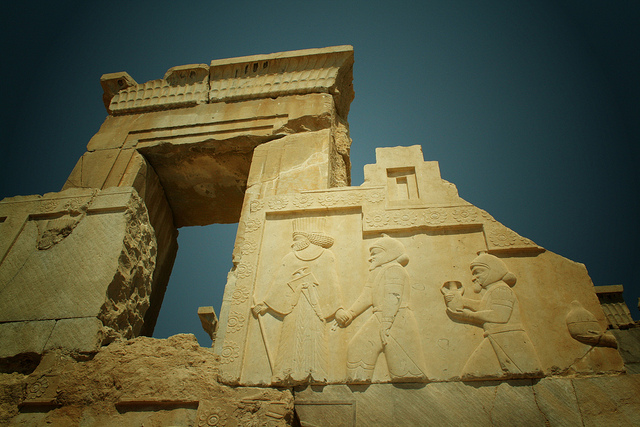
Israeli and Arab leaders have spent years warning of the rise of an Iranian-led Shia empire covering much of the Middle East. With Iran now linked to the Mediterranean through a land corridor that extends through Iraq, Syria and Lebanon, many are claiming vindication. But fear of Iran as a regional hegemon is vastly overblown.
There is no denying that the Middle East is rife with localised conflict, often fuelled by rivalries among warlords. But a major conflagration is in no regional actor’s interest. This is particularly true for Iran, which is incapable of projecting conventional military power beyond its borders.
In fact, Iran’s nuclear program was intended to compensate for its conventional military weakness in a neighbourhood where it has more enemies than friends. Yet, by spurring the international community to impose crippling sanctions, Iran’s nuclear effort ended up undermining the country’s progress further, by impeding technological progress and military investment. Meanwhile, its enemies, particularly Israel and Saudi Arabia, which both have far larger military budgets, were acquiring the most advanced Western military technologies.
Given this weakness, Iran’s land corridor, which inspires so much fear in its regional neighbours, depends on unreliable local proxies, making it unsustainable. And that doesn’t even account for its vulnerability to American air strikes.
Iraq, a vital link in the corridor, was supposed to be Iran’s unconditional Shia fiefdom. But ending the dominance of the Popular Mobilization Forces (Hashd al-Shaabi), an Iran-sponsored umbrella of Shia militias, in areas vacated by the Islamic State (ISIS) is a top priority for Iraqi Prime Minister Haider al-Abadi, who has the backing of Iraq’s supreme Shia authority, Ali al-Sistani.
The situation in Syria is more complicated, but not much more favourable to Iran, which, after years of propping up President Bashar al-Assad’s regime, has found that the real hegemon in the country is Russia. President Vladimir Putin knows that convincing the Sunni rebel groups to lay down their weapons as part of an effective peace agreement will be a lot more difficult if Iran retains a large presence in the country. Likewise, Assad knows that he cannot hope to build bridges with Syria’s Sunni majority if his regime is administering an Iranian protectorate.
Yet Iran’s biggest problems in Syria are the United States and Israel. The former has maintained its military presence in the country, even after having defeated ISIS, in order to prevent Iran from consolidating control. And Israel’s potent air force would never allow a meaningful Iranian military presence in Syria. Iran’s leaders know that risking a war there would leave their country’s nuclear infrastructure vulnerable.
Iran’s influence is also faltering in Lebanon. After years of service to the Assad dynasty, Hezbollah is now working to recover its domestic legitimacy, even pushing for the return of Saad Hariri, the Sunni leader of the anti-Iranian March 14 Alliance, to his post as prime minister. This reflects a strong desire to maintain some semblance of institutional order in Lebanon, and indicates that a war with Israel is no more in Hezbollah’s interests than it is in Iran’s.
To be sure, Iran, much like the Soviet Union, has long viewed expansion abroad as the best way to protect the revolution’s results at home. But, as both Soviet and Iranian experience has shown, failure to manage domestic challenges poses a greater threat to the regime’s legitimacy. While the future of Iran’s land corridor depends on its foreign proxies, the Islamic Republic’s future depends on its leaders’ capacity to deliver at home.
Yet Iran’s leaders seem to be placing their proxies above their citizens. Despite the failure of the 2015 nuclear deal to meet Iranians’ high economic expectations, the authorities continue to spend billions of dollars on the likes of Hezbollah, Hamas in Palestine, and the Houthis in Yemen. Iran has spent close to $10 billion in Syria alone to prop up Assad.
The resulting fiscal strain has forced Iran to slash some of the lavish subsidies that have long buttressed the regime’s popular support. Protests staged by mostly working-class young men against deep reductions in food and fuel subsidies quickly evolved into demonstrations against Iran’s theocracy, reflected in chants of ‘Death to Ali Khamenei’, the Islamic Republic’s supreme leader.
Three generations is a long time for any revolutionary utopia, whether Iran’s Islamic Republic or the Soviet Union, to survive, as citizens become increasingly disconnected from—and even sceptical of—the original cause. This is all the more true today, when digital technology has deepened the generational divide.
In the 1980s, in the face of a brutal assault by Saddam Hussein’s Iraq, Iranians rallied behind the regime to ensure their country’s survival. They will not submit to similar hardships today in the name of maintaining outposts in Syria and Yemen, or a land corridor to the Mediterranean. With about half of Iran’s population under the age of 30, and youth unemployment at around 25%, it should come as no surprise that some recent demonstrators chanted, ‘Give up on Syria! Think of us!’
Iran’s interest in avoiding all-out war should be good news for its enemies, which are not in a particularly strong position to manage further foreign military entanglements. Saudi Arabia, in particular, is facing difficult domestic reforms, including efforts to diversify its economy, while mired in its own military interventions in Syria and Yemen.
Iran can be a spoiler in the Middle East, but not a hegemon. To argue otherwise, as Israeli and Arab leaders are wont to do, merely makes more likely a horrifically bloody, destructive and destabilising conflict that all parties have a fundamental interest in avoiding.

